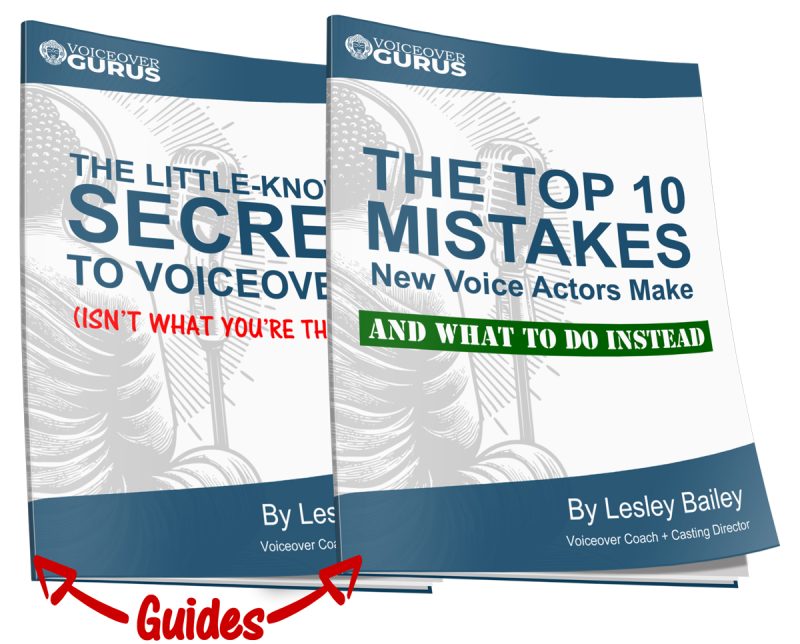– For Animation, Commercials, Audiobook narration and more …
In voice acting, “suspending disbelief” is not just something we hope the audience will do—it starts with us. If we don’t believe in the world of the script, why should anyone else?
Whether you’re voicing a goblin king, a toothpaste spokesperson, or a grieving widow in an audiobook, your job is to make the performance feel authentic, not “performed.” That means getting past surface-level choices and into full emotional and psychological commitment.
So how do you do that? How do you make the unreal feel real? How do you breathe life into a script so completely that listeners lean in, trust you, and feel like they’re right there in the moment with you?
Here are the top 7 ways to suspend disbelief in voice acting—and fully own the script, whatever the genre.
1.
Don’t Act the Words—Live the Circumstance
One of the biggest traps in voice acting is focusing too much on the words. We try to “make it sound good” or “sound like a character” instead of truly stepping into the situation. The result? A performance that feels hollow or theatrical rather than lived-in.
Instead of: “How should I say this line?”
Ask: “Why is my character saying this now, to this person, in this moment?”
Even in commercials, there’s a circumstance. You’re not just reading copy—you’re solving a problem. You’re someone who has discovered the softest socks, the tastiest protein shake, or the most freeing travel insurance—and you need to tell us.
In animation and audiobooks, this is even more essential. Step into the emotional stakes of the moment. What are the character’s goals, fears, desires, or grudges? What just happened before this scene? What’s at risk?
Pro tip: Record a version of your script where you improvise a few lines before the real script begins. Set the scene for yourself emotionally. It’s easier to step into a moment if you lead yourself there.
2.
Use Subtext Like a Secret Weapon
Subtext is what your character really means underneath the actual words. It’s the difference between reading lines and revealing a relationship.
For example, “I’m fine” can mean “I’m deeply hurt,” “Back off,” or “This isn’t the time”—depending on what’s going on under the surface.
Every line of VO—yes, even in a car commercial—has potential subtext. Maybe the announcer voice is actually thrilled, smug, in love with their car, or slightly condescending. Those colors matter.
In audiobooks, narrators often have to differentiate between dialogue, narration, and character thoughts. Subtext helps with that. What’s the emotional engine of the scene? What are characters hiding, revealing, resisting, or longing for?
Exercise: Read your script aloud, then underline the subtext—the emotion, attitude, or belief behind each line. Then re-read it while focusing on that deeper truth. You’ll find more nuance, rhythm, and specificity emerge naturally.
3.
Anchor with a Strong Point of View
Suspending disbelief begins with having a clear opinion as the speaker.
In other words, what does your character (or narrator, or spokesperson) believe about what they’re saying?
A point of view gives energy and shape to your performance. It sharpens your choices. If you’re voicing a commercial about a new energy drink, what’s your take on it? Are you skeptical at first, then converted? Are you a longtime fan who can’t believe everyone else hasn’t caught on? Are you a playful rebel trying to win people over?
In animation, a strong POV makes characters dimensional. They’re not just “the villain” or “the sidekick”—they’re someone who believes they’re right, justified, or misunderstood. That belief makes them real.
Narration tip: Even if you’re just “the narrator,” you still have a perspective. Are you curious? Detached? Warm and knowing? The listener senses your stance even in neutral descriptions.
4.
Bring Your Body Into It
Voice acting is not just “talking into a mic.” It’s physical storytelling.
Your breath, posture, tension, and gestures all influence your vocal choices—often in ways you’re not consciously aware of. Want to sound more grounded? Try standing with your feet planted and your spine tall. Want to capture nervous energy? Try pacing lightly while reading. Want to sound intimate? Try leaning in slightly and softening your jaw.
For animation: Get out of the booth chair if you can. Use your hands, shift your weight, embody the character. You’ll naturally vary pitch, tempo, and texture in ways that feel alive.
For commercials: Try holding a product (or a substitute) in your hand. It’s easier to sound like a real person recommending something when you’re physically engaged.
For audiobooks: Take on the character’s posture as you narrate their parts. Hunch slightly for the old man, lift your chin for the haughty aristocrat. These tiny body shifts create vocal nuance that’s hard to fake.
5.
Visualize Like an Actor, Not a Reader
Imagination is your best tool for suspending disbelief. If you can see it, feel it, and believe it, we will too.
Voice acting is essentially painting with sound. Your voice must carry the world of the story, the tone of the room, the stakes of the moment.
Before recording, close your eyes and ask:
- Where am I?
- Who am I talking to?
- What’s in the room? What’s in my hand?
- What just happened a moment ago?
The clearer your inner movie, the more grounded your performance.
Audiobook narrators: Use visualization to keep long passages vivid. Imagine the setting of each scene. See the flicker of candlelight or the crunch of gravel. It helps you differentiate pacing and tone without even trying.
Commercial VO: Imagine your audience. Are you speaking to your best friend? A new parent? A skeptical teen? Visualize their face as you deliver the line. It changes everything.
6.
Stay Present—Don’t Pre-Plan the Read
Suspending disbelief requires presence. That means being in the moment with the character—not planning your inflection or “performing” the line how you think it should sound.
Ironically, many voice actors lose authenticity by trying to be too polished. They emphasize the right syllables, use the “right” voice, and hit every cue—but it feels artificial.
True presence means you don’t know exactly how the line will come out—and that’s what makes it compelling.
Allow for discovery. Leave a little room for surprise. React to your own words. Take a beat to think before answering a question in the script. Add a sigh or a pause if it feels honest.
In animation: Use impulses! If a sound or gesture wants to happen, let it. That spontaneity is gold.
In audiobooks: Don’t lock in voices so tightly that they become mechanical. Stay emotionally present—let each moment unfold as if for the first time.
7.
Trust That You Are Enough
This one might sound fluffy—but it’s the deepest, most critical piece of all.
A lot of voice actors get in their own way by thinking they have to “be more interesting,” “add something special,” or “sound like” a character. In trying to sound like someone else, they lose their connection to truth.
But when you trust that your honest, fully-invested voice is enough, your performance transforms. You start to act from the inside out instead of the outside in. That’s when you suspend disbelief—because you’re not pushing or pretending anymore. You’re being.
For commercials: The most compelling reads often sound like a real person talking to someone they care about. Not a “voice actor.” Just you—with real conviction and clarity.
For character work: Don’t chase weird voices. Let the voice emerge from your character’s needs, wants, and personality. When you act first and shape sound second, it always lands better.
For narration: Trust your voice to hold the space. You don’t need to “perform” the book. You need to understand it, care about it, and bring it to life with focus and warmth.
Final Thoughts
Suspending disbelief isn’t about faking it better—it’s about believing it deeper. When you live inside the moment, know what’s at stake, and speak from a real emotional place, the audience feels it.
Great voice acting isn’t about tricks or vocal fireworks. It’s about commitment. Clarity. Connection.
So the next time you step into the booth—whether it’s for a cereal ad, a cartoon hero, or a dark literary novel—don’t just say the words.
Believe them. Live them. Own them.
The rest will follow.
Want to go deeper with your voice acting?
Check out our Voiceover Jumpstart Session to build confidence, sharpen your craft, and take your reads to the next level.


 Hi! I’m Lesley Bailey. I’m an award-winning Casting Director, Voiceover Coach, Demo Producer, and Consultant with over 30 years “in the trenches”. I love helping voice actors bring scripts to life with authenticity and confidence.
Hi! I’m Lesley Bailey. I’m an award-winning Casting Director, Voiceover Coach, Demo Producer, and Consultant with over 30 years “in the trenches”. I love helping voice actors bring scripts to life with authenticity and confidence.